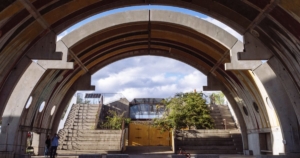Arizona camping: 15 essential tips and gear from experienced campers
Arizona camping offers unique challenges and rewards for outdoor enthusiasts. This article presents essential tips and gear recommendations for a successful camping experience in the Grand Canyon State. Drawing from the wisdom of seasoned campers and outdoor experts, these insights will help ensure a safe and enjoyable adventure in Arizona’s diverse landscapes.
DEEPER DIVE: Here’s where the residential real estate market stands in 2025
LOCAL NEWS: 100 best places to work and live in Arizona for 2025
INDUSTRY INSIGHTS: Want more news like this? Get our free newsletter here
- Stay Hydrated in Arizona’s Desert Heat
- Protect Against Insects for Comfortable Camping
- Use a Tarp for Shade and Wind Protection
- Be Aware of Flash Flood Risks
- Pack a Mylar Blanket for Temperature Swings
- Bring Thick Ground Cover for Comfortable Sleep
- Protect Your Feet with Proper Footwear
- Use Electrolytes to Prevent Dehydration
- Choose a Well-Ventilated Tent for Arizona Camping
- Store Food Properly to Avoid Wildlife Issues
- Supplement with Electrolytes for Health Concerns
- Prepare for Arizona’s Diverse Camping Environments
- Be Ready for Desert Wildlife Encounters
- Respect the Unpredictable Arizona Desert Climate
- Essential Gear for Safe Arizona Camping Adventures
Stay Hydrated in Arizona’s Desert Heat
If I had to give one piece of advice, it would be to carry and drink more water than you think you need. A single gallon per person per day is the baseline, but in desert heat, you can burn through that quickly. I mean, swinging a hammer on a 95-degree roof for six hours taught me how fast dehydration creeps up — once it does, you are already behind. Stash extra bottles in your pack, in your vehicle, and even in the tent. Keep them shaded or insulated because water that tastes like hot metal is the last thing you will want to drink.
The other non-negotiable is solid sun protection. Long-sleeve breathable shirts, a brimmed hat, and something as simple as a $10 reflective tarp can turn a blistering campsite into a livable space. A small tarp strung four feet above your tent drops the interior temperature noticeably, the same way a roof overhang cools a porch. Add in a headlamp, a basic first-aid kit, and you are equipped for most scenarios short of a monsoon.
Tyler Hull, Professional Roofing Contractor, Owner and General Manager, Modern Exterior
Protect Against Insects for Comfortable Camping
If you are planning to camp in Arizona, you must bring insect protection no matter what time of year you go. Most people only think about heat and sun first, which makes a lot of sense, but once you are in a place that is close to rivers, creeks, or even small pools of still water after rain, the biting insects become relentless. What started as a perfect afternoon turned into hours of swatting and scratching, and I wasn’t the only one. We all in our group had misjudged how fast the bugs would overrun us when the sun set.
Now, I never go out without a good repellent, a head net when I know I am going to be exposed to standing water, and lightweight long sleeves that are breathable. It keeps me comfortable at night when I am trying to get some rest or just sitting outside and breathing in the air. People prepare mostly for the heat, but they rarely consider how insects can ruin the trip just as fast if you are not ready.
Caspar Matthews, Director, Electcomm Group Electrical & Data
Use a Tarp for Shade and Wind Protection
Bring a tarp and know how to use it. Not for the tent, not for the ground, but for shade, pure and simple. The Arizona sun can slap you in the face by 9 a.m. and cook your water bottles by noon. You may rig up a basic 10-by-12 tarp with paracord and a few carabiners. Nothing fancy, just something to break up the sun between camp chores or while you sit and eat. It’s lightweight, cheap, and more useful than half the gear people bring.
Heat gets most of the attention, but that desert wind will eat you alive if you do not anchor things down. Tie things up, weigh things down, and always stash your gear before dark. The place is quiet, but it does not forgive lazy setups. A solid tarp and a tied-down camp can make or break your whole trip.
John Washer, Owner, Cabinets Plus
Be Aware of Flash Flood Risks
If you are planning to camp in Arizona, make sure to check the monsoon forecasts before you go. The reason is that certain regions experience flash floods that arrive with very little warning. I have literally seen perfectly dry riverbeds transform into torrents of water in less than fifteen minutes. Even a light rainstorm miles away can send a wall of water into a canyon or low-lying area where you might be set up.
On a camping trip in the area around Sedona, two of my friends and I were camping at a distance of about 40 meters from a normally dry wash. We had chosen the position because it was on flat ground and had shade, but a storm upstream sent a flood of water through the wash more quickly than we anticipated. In a few minutes, the water level increased to almost a meter and washed away pieces of debris as large as small logs. We were forced to quickly move our camp uphill, and even then, the ground where we had been sleeping was underwater for the whole night.
Chris Kirksey, CEO / SEO Specialist, Direction.com
Pack a Mylar Blanket for Temperature Swings
Here is my one must-have: a cheap silver mylar blanket. I mean, it costs maybe $3, weighs less than a protein bar, and makes the difference between a rough night and hypothermia in the desert. Arizona’s temperature can drop 40 degrees quickly once the sun goes down. I have hiked out at 6 p.m. in 90°F, then woke up shivering in 44°F by 3 a.m. Even with a $200 sleeping bag, that foil sheet saved my sanity. Just stash one in your bag. Done.
Oh, and keep water in an insulated bag. Leave a plastic jug out and it boils by noon. Trust me, drinking 120°F water with your beef jerky is a brutal combo.
Patrick Beltran, Marketing Director, Ardoz Digital
Bring Thick Ground Cover for Comfortable Sleep
My advice is to pack a serious ground cover: something thick enough to block heat and sharp rocks. Even in the cooler months, the ground in Arizona holds heat long after sunset, and regular sleeping pads won’t suffice. We use moving blankets or heavy-duty foam when working on driveways or concrete, and that same trick works well under a tent. It makes the difference between sleeping and tossing around all night. After a few hours on baked desert ground, you’ll wish you had brought that extra layer.
Most folks focus on sun gear and water, which matter, of course. However, that extra layer under your tent changes your whole trip. It adds comfort, reduces cleanup, and protects your gear from wear and tear. If you’re setting up camp for more than one night, you’ll feel the payoff after the first morning. Arizona’s terrain is rough, but small choices like this make it easier to enjoy the view without dreading bedtime.
Craig Focht, Cofounder & CEO, All Pro Door Repair
Protect Your Feet with Proper Footwear
My advice for anyone camping in Arizona is simple: protect your feet. The desert looks soft in pictures, but the ground is hot, rough, and sometimes hides tiny cactus needles you won’t see until it’s too late. I always wear closed-toe shoes with thick soles and never walk around barefoot, even just around the tent. Once I made that mistake and ended up with a thorn so deep I couldn’t hike the next day. It completely changed the vibe of the trip, from peaceful to painful.
I even pack a small foot-care kit now with bandages, blister pads, and tweezers just in case. It might sound dramatic, but your feet are your freedom out there. If they’re hurting, you’re stuck. Arizona has this wild, rugged beauty, and I want to actually enjoy it, not limp through it.
Jack Johnson, Director, Rhino Rank
Use Electrolytes to Prevent Dehydration
Electrolyte products are a must when you’re camping and hiking in Arizona, as the desert’s insidiously dry heat can cause dehydration to strike suddenly, converting fun outings into potentially unsafe conditions within just an hour or two. While scouting possible cultural outings near Sedona on a research visit, I watched as family members from Minnesota suffered severe dehydration after only three hours of moderate hiking despite the water bottles they toted along. Unknowingly, Arizona’s dry climate causes sweat to evaporate and be unnoticeable, making it impossible for anyone in this challenging condition to account for what was depleting until symptoms are so severe it requires emergency room intervention, causing them embarrassment but also the end of their visit with a traditional Navajo artist studio.
To help offset these risks, start drinking water 24 hours before you even head out to the woods and mix in tablets or powders that contain electrolytes (replacing valuable minerals lost through continuous sweat from Arizona’s dry heat). Choose your camping spots near places with opportunities for authentic cultural exchanges; stargaze with local astronomy guides who tell stories about traditional desert navigation, and visit pueblos where artisans use materials appropriate to the harsh landscape in morning light. When you bring hydration planning together with cultural exchange, camping in Arizona becomes less about surviving and more about discovery; discovering the natural beauty of what some view as a barren desert wilderness along with heritage passed down by Native Americans that has nourished people despite these harsh yet beautiful surroundings for thousands of years.
Yunna Takeuchi, Co-founder & CXO, City Unscripted
Choose a Well-Ventilated Tent for Arizona Camping
If you are camping in Arizona, always make sure to bring with you a tent that has good ventilation features. This is one of the things I got to learn the hard way during a summer camping trip. It is swelteringly hot in Arizona, and the heat of the day can even reach more than 100 degrees Fahrenheit. Inadequate airflow inside your tent will turn it into a sauna, and you will hardly be able to sleep. I learned this when I tried to camp in a conventional, closed tent mode at the height of summer. This absence of airflow made the tent an oven, and I spent the whole night sweating and not getting any sleep. Ever since, I always prefer a tent that has big mesh windows and several doors to cross-ventilate. This keeps the air flowing even on the hottest days.
Steven Bahbah, Managing Director, Service First Plumbing
Store Food Properly to Avoid Wildlife Issues
Put all foods in scent-free bags or containers if you are going to camp anywhere in Arizona. The reason for this is that even outside of bear territory, desert wildlife will still come after anything with a scent. Ringtails, raccoons, skunks, and rodents can pick up the smell of food from surprising distances. They will tear the backpacks, chew through tents, and leave the place in a mess that destroys your equipment and your night.
If you are staying more than one night, it is even more important. The animals remember the places where they got food and they return there. Learning to pack correctly the first day will not only save you money on your gear but also prevent stress and keep your campsite clean. Being smart at the beginning saves you troubles that you would not like to encounter at night.
Daniel Vasilevski, Director/Owner, Pro Electrical
Supplement with Electrolytes for Health Concerns
Carry an electrolyte supplement and take it daily, particularly if you have a chronic ailment. The dry climate in Arizona causes dehydration to set in faster than you might realize, and the altitude in certain areas can also increase fatigue, headaches, and joint pains. We have observed flare-ups of symptoms in patients who underestimated the rate at which the desert removes moisture and minerals from the body, even in cooler months.
Choose an electrolyte powder that does not contain sugar or caffeine and mix it with your regular hydration. This single change has had a significant impact on many people within our community, including those with fibromyalgia or ME/CFS. It’s not only about being hydrated — it’s about providing your body with what it needs to stabilize under more challenging conditions. The environment should be considered extreme rather than merely rugged when proactive recovery is essential.
Maegan Damugo, Marketing coordinator, Health Rising Direct Primary Care
Prepare for Arizona’s Diverse Camping Environments
For first-time campers, especially those from outside the region, the state’s diverse and extreme environments require careful consideration and preparation. It is prudent to always have more water than you anticipate needing; the arid deserts pose a serious risk of dehydration. An electrolyte tablet is also essential. Bring different layers of clothing, as the daytime heat can be intense, but higher elevations can get surprisingly cold at night. High-altitude, lightweight tents are wonderful options; their proper ventilation is critical to withstanding heat and unpredictable rain.
Travel insurance is a must for non-residents, as it protects you from unexpected medical situations, such as hiking injuries or emergencies due to wildlife encounters. It will also be wise to carry a first-aid kit that includes snakebite treatment. Broad-brimmed hats, UV sunglasses, and sunscreen are also critical for protection against the intense UV exposure in Arizona. Most importantly, know the region and terrain: Arizona is breathtaking but unforgiving, so the area requires a high-res map, GPS, and local guidance for safe travels.
Joe Cronin, President, International Citizens Insurance
Be Ready for Desert Wildlife Encounters
If you’re camping in Arizona during the summer, my advice is simple: be ready for creatures. My buddy and I went once thinking we were prepared, but we definitely were not. Our first site had a full ant nest actively hunting for crumbs, and the second had a black widow just hanging out under the bench. We bailed and started driving.
On the way out, we noticed these weird dark patches moving across the road. It was dozens of tarantulas migrating. I’m all for nature, but if you’re going out there, bring a headlamp, shake out your shoes, and check every surface before you sit down. It’s beautiful country, but it comes with company.
David Hill MD, Plastic Surgeon & Medical Director, Fulcrum Aesthetics & Surgery
Respect the Unpredictable Arizona Desert Climate
When camping in Arizona, my best recommendation is that you respect the desert because it is beautiful, but it is unforgiving. Climates are unpredictable, as one day it is sweltering and the next day freezing. Do bring thick clothes to keep warm at night and sunscreen to protect yourself during the day. Essential gear? A hydration pack, high-SPF sunscreen, a wide-brimmed hat, and a map or a GPS. Cell signal might be hit or miss in that area. And do pay attention to fire restrictions; a good camp is always spoiled by the risk of a wildfire.
Steve Wyatt, Host, Wyatt Matters
Essential Gear for Safe Arizona Camping Adventures
Arizona camping rocks, but remember: heat and terrain matter. I learned the hard way that even when it’s cooler, water is a must. Have extra, plus electrolytes. Shade is also key. A light tarp makes midday stops way better. Temps change a lot, so layer up. Desert nights can be cold. Wear tough shoes, not sandals. Cacti and snakes are real. Know your route and have a signal plan. Cell service can disappear, and you want to enjoy the view, not stress out.
Dwight Zahringer, Founder, Perfect Afternoon



